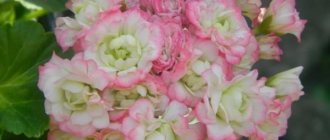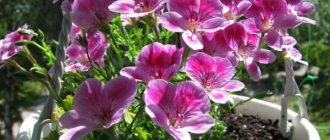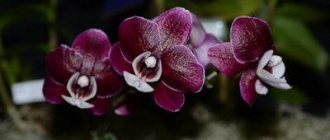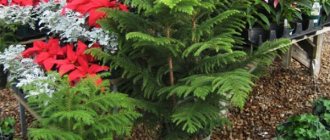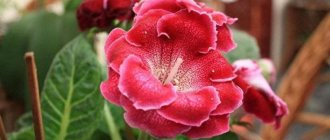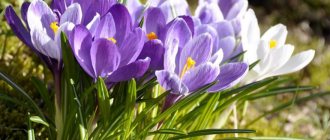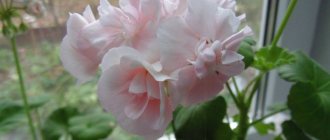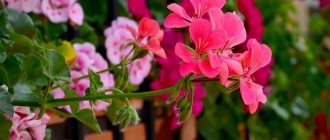Care
The soil
Although pelargoniums are not particularly capricious plants, not all types of soil are suitable for them. The biggest problem for the plant is caused by poorly drained soils, when moisture can stagnate, thereby causing various diseases. Clay compounds and loams are especially dangerous. Pelargoniums grow best in peat-based soil. Soil, a third of which is sand, will also work.
Watering
Pelargonium is able to withstand significant droughts and maximum outdoor temperatures for a very long period of time. For normal growth, it is enough to water the flowers once a week. If the flower grows in southern latitudes, in winter watering can be reduced to once a month, but in the spring, starting in March, a sufficient amount of moisture can be added to the soil again.
But some cultivated and ornamental varieties require more water. In the hottest months of summer, watering should be done once every 2 days. It is important to remember that young plants always need less moisture, since their root system is not yet very developed, and the liquid will simply stagnate. Overwatering will instantly cause root rot. Also, watering must be carried out on the stem of the plant, without splashing water on the leaves and flowers. The best time to water is early morning.
Fertilizers
During the active growing season and flowering, pelargoniums need feeding. The easiest option is to add a small amount of fresh compost in the spring, scattering it around the bushes. An alternative is to fertilize with liquid potassium fertilizer, which is added to the water when watering.
Important! Pelargoniums should not be fed with fertilizers high in nitrogen. This substance will greatly stimulate leaf growth, which, in turn, will affect flowering.
Trimming
Pelargoniums need to be constantly forced to stop growing by pruning, otherwise beautiful garden plants will turn into wild bushes without flowers. As a rule, the pelargonium bush is trimmed so that it resembles a ball.
Decorative pelargoniums are prone to excessively active propagation by seeds, so every spring it is necessary to trim off new shoots that appear from the ground.
The main pruning is carried out in the fall, when the phase of active growth and flowering has already ended. Before wintering, approximately 1/3 of the leaves and all faded buds must be removed from each bush. This will ensure sufficient light penetration into the bush and good ventilation. The longest branches are pruned above the node where the leaves grow. To prevent the development of diseases after pruning, use a weak solution of a fungicide or a water mixture with a weak alkali. In spring, fresh flowers will appear at the cutting site.
Lighting
Considering the homeland of pelargonium (South Africa), the plant prefers direct sunlight throughout the day. Most breeding varieties can grow in partial shade, but it is better not to place flowers under dense tree crowns, otherwise the number of new buds will be reduced several times (unlike growing in sunny meadows). When grown at home, pelargonium should always be placed on the windowsill on the sunny side.
Temperature
The optimal temperature regime for pelargonium is +15-18 degrees Celsius. At a temperature of +10 degrees, the plant will still produce color, but if below this limit, it will gradually begin to hibernate.
Preparing for winter
Considering that most pelargoniums are perennial varieties, you will have to take care of their wintering in advance. The plant absolutely cannot tolerate temperature drops below 0 degrees Celsius; frosts on the soil will completely destroy any species or variety. Around October, before the first frost, it will be necessary to build a full-fledged greenhouse over the garden pelargonium or temporarily transplant the plant into a warm room. Covering the bushes with an additional layer of insulating materials or mulch will not give the desired effect.
Description of the variety
Pelargonium Apple Blossom appeared in South Africa. Back in the seventeenth century, the flower was brought to Europe. A hundred years later, gardeners identified it as a separate variety. It is believed that the species arose by chance, through an unexpected mutation. Then it reached its modern form when it was crossed with other varieties (approximately this happened in 1870).
Rosebud is considered a double plant. The appearance of the inflorescence resembles a pink bud that is about to open completely. Geraniums are often confused with a rose growing on a bush. That is why it is called Rosaceae pelargonium. But flowers differ from roses in their leaves.
Pelargonium Apple Blossom Rosebud
Pelargonium Apple Blossom is a perennial plant that loves light. It is worth highlighting several points that characterize this inflorescence, which belongs to the geranium family:
- The rhizome of the flower is dense;
- the plant has a herbaceous and rigid stem, which often becomes lignified from the root in older species;
- the leaves look like circles with a cutout not exceeding a third of the width;
- the fruit of the flower is in the form of a box;
- propagated by seeds, cuttings, by dividing bushes;
- loves warmth.
Important! The plant needs to be watered abundantly, but not often.
There are no thorns on the stem. The inflorescence has the shape of a ball, for the beauty of which flower growers, even beginners, want to have this particular flower in their garden.
Pelargonium Apple Blossom Rosebud does not look pretty in winter. The stem becomes bare, as the leaves turn yellow and fall off, and there is no flowering at all. The developed geranium variety blooms all the time, except in cold weather. The seeds are large, they can be collected and planted in a cup in the fall in order to transplant the sprout into the ground in the spring. The plant is quickly accepted and begins to bloom immediately.
Many inexperienced flower lovers use incorrect plant names:
- pelargonium Appleblossom rosebud;
- pelargonium Appleblossom rosebud;
- Pelargonium Appleblossom.
Features of transplanting pelargonium
- Before replanting pelargonium, it is necessary to lightly trim its lower leaves.
- Carefully dig up the plant and clean the roots from the soil, allowing them to dry a little for 1-2 hours.
- To plant in a garden plot, prepare the required number of holes and a mixture of universal soil, compost and perlite. This composition will need to be buried in the plants in a new place.
- Moisten the soil slightly before planting.
- We free the lower part of the plant trunk from leaves by about 10 cm.
- Inspect the roots for rot, cut off damaged parts with pruning shears or garden shears.
- Place the plant in the hole at the same depth of the stem as it grew in the same place, and bury it with the previously prepared soil mixture.
- Water each bush thoroughly.
You can cover the ground with a thin layer of mulch on top to retain moisture until complete rooting.
Types of pelargonium
In total, there are more than 250 plant species in the pelargonium genus. Moreover, botanists from different countries continue to argue regarding the classification. There are only 6 cultivated species, but the number of ornamental varieties is simply enormous.
Pelargonium is zonal. The species became most widespread and was one of the first to be cultivated. It includes more than 75,000 varieties. The plant with branched, fleshy shoots and dense, rounded leaves grows quite quickly. There is a lighter spot (zone) on the leaf blade in the central part. It is surrounded by a bright border. Flowering is very abundant. Up to a dozen large umbrellas with bright colors can appear at the same time. The foliage exudes a specific aroma. The varieties are divided into thematic groups:
- Pelargonium tulipaceae. Even the blooming flowers remain quite narrow and resemble tulip buds. Each inflorescence bears a large number of flowers.
Pelargonium tulipaceae
- Terry pelargonium. Each flower has 9 or more petals:
- dovepoint - a dwarf bush with large white and pink flowers;
brookside Katerina – bright pink flowers;
- magnus is a compact, slow-growing shrub with dark green leaves that produces rich red flowers;
- saxdalens selma – abundantly blooms dense pink buds;
- wendy real – dwarf plant with salmon-pink corollas;
- sister henry – a medium-sized bush with dark green leaves that blooms dense bright pink inflorescences;
- bold gold – golden-green leaves combined with salmon buds;
- pensby - a tiny bush with dense inflorescences of soft pink buds;
- Kenny's Double is a medium-growing plant that produces many buds of crimson-red flowers at once.
- Pelargonium rosebud (rosaceous). Plants with double flowers that look like small roses.
- april snow – flowers in the form of tiny white roses with a pink border on the petals;
shelk moira - a dwarf bush covered with coral, rose-like flowers;
- anita – blooms with small white-pink flowers and grows large shiny leaves;
- vectis rosebud is a dense compact bush with bright red buds.
- Non-double pelargonium. Plants with simple five-petaled flowers.
- bob newing - angular palmate leaves have a variegated color of dark green, white and pink, flowers are solid, red.
Non-double pelargonium
Pelargonium terry
Pelargonium rosebud
Pelargonium fragrant. A shrub with branched, short shoots is covered with petiolate foliage that is round or heart-shaped. The width of the leaves reaches 5 cm. They have uneven, as if torn, edges and are covered with short pile. The leaves emit an intense, pleasant aroma. Depending on the variety, it contains notes of rose, pineapple, pine, apple, peach, etc. In May-September, multi-flowered round umbrellas with small pink or white flowers bloom, but they attract little attention.
Pelargonium fragrant
Pelargonium ivy-leaved (ampeloid). Creeping shoots grow 25-100 cm in length. They are covered with smooth, angular leaves, like ivy. Depending on the variety, the flowers are double or single. They are collected in dense inflorescences. A popular variety is green eyes - semi-double or double white-violet flowers with a green eye in the center.
Pelargonium ivy-leaved (ampeloid)
Royal pelargonium. A very beautiful, but capricious plant. It is distinguished by its large size and powerful branched shoots. The dense crown is up to 50 cm in height. The wide serrated foliage is similar to maple. Large flowers with ruffled petals grow 4-7 cm wide. The color is dominated by purple, pink, and scarlet colors. The petals are always variegated. Plants definitely need a period of rest. Flowering lasts no more than 4 months.
Pelargonium royal
Pelargonium grandiflora (large-flowered). A branched shrub up to 1 m in height is covered with lobed or dissected leaves on long petioles. The foliage is bare or slightly pubescent. Each peduncle bears 1-3 flowers with a diameter of 3-4 cm. There are red strokes on the white petals. Flowers bloom in April-June.
Pelargonium grandiflora
Pelargonium angel. The species was obtained as a result of interspecific selection. It is distinguished by smaller (1-2 cm in diameter) foliage and creeping shoots. The plant is less capricious and grows quickly. It produces simple asymmetrical flowers with larger upper petals. The mole variety produces erect, branched stems covered with light green foliage. The tops are decorated with few-flowered inflorescences with white and burgundy petals.
Pelargonium angel
Features of plant flowering
Pelargonium PAC Viva Carolina - description, planting and care
The culture is distinguished by abundant and lush flowering. To grow a beautiful bush, you need to take good care of it.
Period of activity and rest
Geranium blooms from early spring to mid-autumn. During the dormant period, pelargonium should be kept in a cool room and should not be fed.
Types and shape of flowers
The culture has lush inflorescences that resemble roses. They are distinguished by a rich or delicate pink color.
Pelargonium is characterized by lush flowering
Reproduction
Propagation of pelargonium by cuttings
The active growth of pelargonium begins with the first rays of the sun, so cuttings can be prepared for spring planting from the end of February to mid-March. Here is a detailed description of the steps for propagating pelargonium by cuttings:
- Choose the strongest and healthiest plant to become a donor.
- Trim small branches above the junction so that 2-3 leaves remain at the end of the cutting.
- All other leaves, except the top ones, are removed.
- Next, lay the cut branches to dry a little. 2-3 hours in a warm room is enough. Just do not place the cuttings in the open sun, otherwise they will simply dry out.
- Each branch is immersed in a glass of water and placed at room temperature on a sunny windowsill.
- The formation of full-fledged roots takes on average 1 week.
Propagation of pelargonium by seeds
Growing pelargonium from seeds is a little more complicated than the cutting process. Typically, the first flowers grown from seed will appear in about 12-16 weeks. The plant can be propagated by seeds at home at any time of the year. If you then want to transfer the seedlings to open ground, it is best to start sowing in January or early February.
Detailed instructions on how to grow pelargonium from seeds are presented below.
- Pelargonium seeds have a hard outer shell, so to increase germination, you need to moisten them by leaving them for 5-6 hours (preferably overnight) in slightly warm water.
- You can significantly speed up the process of seed germination. To do this, they are laid out on a wet towel and covered with a cloth in two layers. An improvised “incubator” is placed in the sun or under a fluorescent lamp. In 1-2 days you will see the first sprouts hatching.
- For sowing, use a universal soil mixture. The container, tray or pot is pre-treated with a fungicide to prevent the appearance of fungal diseases.
- Moisten the soil until it looks like a porous sponge. Allow the moisture to be evenly absorbed into the soil for 1-2 hours.
- Make small holes in the soil (2-3 cm deep), into which place 2-3 seeds and sprinkle with soil, then water generously again.
- Pelargonium seeds do not need sunlight to germinate. A warm room with a temperature of 21 to 24 degrees Celsius is sufficient. If this temperature cannot be achieved, create a greenhouse effect by covering the tray with film or glass.
- The first shoots will appear above ground within a week.
After germination, the film/glass is removed and the young seedlings are placed on a lighted windowsill. - The seedlings will need 2-3 weeks to get stronger. During this time, take a closer look at the sprouts and gradually remove the weakest and smallest ones.
- The soil should always remain moist throughout the growing process.
Diseases and pests
The best way is to prevent diseases and pest attacks . And this requires timely detection and prevention. Any problem already has external manifestations at the very beginning:
Are the leaves withering? This may indicate that the room is too warm or the plant is close to the radiator. Perhaps you should increase watering and increase air humidity.- If the leaves change color, this may be a signal that the flower is watered too much or does not have enough light. Or both.
- Are there brown spots on the leaves? This is a viral infection. Replant the flower in a different soil. The plant should also be treated with fungicides. Be sure to check for the presence of parasites. And regardless of the results, you need to spray the flower with an aspirin solution (1.25 per 10 liters of water).
- Are the flowers starting to dry out? Perhaps it's a fungus. Pelargonium should be treated with Bordeaux mixture 5% or phytosporin.
- If a whitefly or aphid has attacked, treat the plant with phytoverim. And at the same time treat all the plants nearby.
- Gray rot is a formidable enemy of pelargonium. Characteristic signs are brown spots on the lower leaves. They spread quickly, and if nothing is done, the plant may die. Treatment is carried out comprehensively. Pelargonium should be treated with a fungicide, eliminate nitrogen-containing fertilizers, reduce watering and spraying, and monitor the looseness of the soil. There should also be enough light in the room.
- If the plant wilts, a fungus may be the cause. Characteristic signs are yellowing and wilting of the lower leaves. Then the yellowness spreads to the remaining leaves. If this happens, pelargonium needs to be treated with trichodermin. In this case, the soil should be changed. Since some types of parasitic fungi persist in the soil for up to 15 years.
Pelargoniums come in different types. Read about royal, pink, variegated, tulip-shaped.
Appearance
Pelargonium is an evergreen perennial. Its strong herbaceous shoots branch strongly and form a subshrub. They are quite meaty. There are varieties with erect or lodging stems. They quickly increase in size. In just a year, a flower can grow by 20-30 cm. The average height of indoor plants is 60-90 cm, which is achieved by regular pruning and rejuvenation.
Pelargonium leaves are petiolate, they grow alternately. The surface of the leaf can be bare, shiny or pubescent. The color is predominantly green; there are species with variegated leaves. The shape of the leaf blades is round, heart-shaped or finger-shaped. The relief of radial veins is visible on the surface.
At home, pelargonium blooms can last almost a whole year, but most often it occurs from May to September. A rather long, bare peduncle grows in the axils of the leaves and on the tops of the shoots. It bears an umbellate, almost spherical inflorescence. Flowers on short stalks are located close to each other. They are painted in various shades of red, white and yellow. The shape of the corolla depends on the variety. Most often it consists of 5 petals, which differ in size.
After pollination, the fruits, the seed pods, ripen. A fully ripe fruit opens at the bottom, like the beak of a crane. Actually, the name “pelargonium” comes from the word “crane”.
Rosaceous pelargoniums (geraniums) – review
I have already talked a little about my beautiful pelargoniums and I would like to dwell in more detail on the characteristics of rosebuds. I only have three: Swanland Pink, Apple Blossom Rosebud and ringless. I’ll tell you about my observations on caring for them; these are not truisms, but a personal opinion.
Rosebud pelargoniums got their name from the shape of the flower, it is like a rose. In other words, this is terry pelargonium.
All pelargoniums feel better at low temperatures: 10-20 degrees. In rosebuds, high temperatures cause the rosette to open incompletely. In the autumn, on the pelargonium loggia they produced the largest possible flowers, almost turning them inside out)))
Apple Blossom Rosebud
Swanland Pink
Rosebud pelargonium with pink flowers. The color is pure pink. It blooms readily, produces a lot of flower stalks, on one Swanland Pink root (everyone lives in a small pot, there is not enough space) all summer there were 4-5-6 flower stalks, from the main and side shoots. Doesn't crumble.
Swanland Pink
Swanland Pink flower size
Apple Blossom Rosebud
Translated as “apple tree bouquet.” The flowers are white with a pink border.
Apple Blossom Rosebud
Apple Blossom Rosebud flower size
In summer, in the sun, the border is intensely pink. In autumn, pale pink, almost invisible (little sun).
October, the border of Apple Blossom Rosebud has brightened
The size of the flower is the same; in cold temperatures it becomes larger. It doesn’t fall off, when the peduncle dries out completely, I break it off. I have it growing in a small pot, but it’s on the south side. Therefore, it bloomed well in the summer (they write about it that the “horse” does not bloom until it gains mass). The first flower appeared on the very baby.
Flowers do not fall off and remain dry
I spend the winter on an insulated loggia, it’s cool there. In the spring, I cut all pelargoniums into fresh ones, because... they “eat up the earth”, the earth after them is empty, like dust.
Rosebud pelargonium does not reproduce by seeds, so you should not look for where to buy seeds.
Reproduction methods
At home, pelargonium is propagated by cuttings and seeds. The vegetative method is used more often, since it is as simple as possible and preserves the varietal characteristics of the mother plant. Most pelargoniums require regular pruning, so material for cuttings is easy to obtain. Usually take sprouts 2-15 cm long with 1-2 nodes. The cut is made perpendicularly with a sharp blade at a distance of 5 mm from the node. If there are flowers, they are removed to reduce nutrient consumption. Large leaf blades are cut in half. It is convenient to root cuttings in water, and when roots appear, plant them in loose, fertile soil. You can immediately identify the sprouts in pots with moist, but not wet, peat. For zonal pelargonium, maintain a temperature of +20…+25°C. Angels, royals and ivies must be kept at +18°C. The rooting process takes from 2 weeks (zonal) to 3 months (royal). The first flowering can occur within six months.
To grow pelargonium from seeds, you need to first prepare the planting material. Seeds with thick skin are scarified. Then they are placed in a damp cloth for a day. Sowing is done in shallow pots with a mixture of perlite and peat to a depth of 3-5 mm. They are sprayed with water and covered with film. During the germination period, the temperature is maintained at +21…+23°C. Shoots appear in 10-15 days. After this, the shelter is removed and the container is transferred to a room with diffused bright light. When 2-3 leaves appear on the seedlings, they are picked into separate pots. Young specimens need brighter lighting, so they use backlighting.
Growing pelargonium Fisher Appleblossom at home, how to care
Pelargonium Fischers Appleblossom is an ornamental crop with lush flowers. For geranium growing to be successful, it requires proper care. It must be comprehensive.
Pelargonium "Appleblossom" - what kind of flower is it, what family does it belong to?
Apple Blossom translates to “apple blossom.” Thanks to the achievements of breeders, it was possible to obtain not only pink flowers, but also other varieties of geraniums. This crop belongs to the Geraniaceae family.
The culture is characterized by beautiful decorative inflorescences
Brief description, history of origin or selection
Pelargonium Appleblossom Rosebud was developed by the Germans. She has approximately 1,200 types of flowers.
Plants of this variety of culture are perennials with branched stems, long peduncles and palmate leaves. Even at home, fruit pods with seeds are formed on the crop.
Varieties of indoor plants with names and what they look like
Pelargonium Dovepoint - description, planting and care
There are quite a few varieties of crops, each of which has certain characteristics.
- Fischers Appleblossom. Pelargonium Fisher Appleblossom is a beautiful rosebud geranium variety. It has soft pink inflorescences with a red or peach border, which form lush clusters. Fisher pelargonium is characterized by abundant flowering from May to August.
- Ungarisk Appleblossom. This is a zonal pelargonium that has rich, velvety petals with a purple border and a white underside. The inflorescences are lush and dense. They have tall peduncles that look very solemn. The culture has powerful bushes of large size.
- Rosebud Westdale Appleblossom. The leaves of this pelargonium have an unusual color. They are characterized by a central zone and a large milky border. The flowers of the plant are white in color and have a terry texture. They resemble half-opened roses. Pelargonium Appleblossom Rosebud is large in size.
- Knight Appleblossom F1. This unpretentious hybrid blooms all year long. The plant has pink-carmine inflorescences with a pink center. The leaves have an unusual color. Their general background is cherry-brown, and along the edge there is a bright green border.
- Exotica Appleblossom. This is a compact plant characterized by dense, pale pink flowers. The culture is characterized by long flowering.
- Happy Appleblossom. The variety is very popular. The central zone of the leaves resembles a butterfly. Tall and slender flower stalks are decorated with white and pink inflorescences.
Important! Pelargonium Happy Appleblossom needs high-quality care and systematic watering. The bushes must be shaped so that they branch.
How to care for Pelargonium Appleblossom at home
In order for a culture to develop normally, it needs to be provided with adequate care.
Illumination and temperature conditions
Pelargonium ivy - home care
The plant requires sufficient light. It should be placed on a south or southwest window. If this is not possible, use special lighting.
In summer, the optimal temperature range is +20… +25 degrees. With the arrival of cold weather, this figure should be at least +15 degrees.
Watering rules and humidity
The plant tolerates drought well and suffers from excessive soil moisture. The crop should not be watered too much. This should only be done when the soil is completely dry. In winter, the soil should not be moistened. The crop can hardly tolerate spraying.
Important! Pelargonium should be watered carefully to avoid moisture getting on the flowers. To do this, you need to use soft, settled water.
The culture needs to be moistened on time
Fertilizing and soil quality
To feed the plant, you can use ready-made formulations. Mineral products or preparations for flowering crops are suitable. However, it is best to use specialized formulations that are suitable for geraniums.
Flower container size
A pot that is not too large is suitable for the flower. As the bush develops, it can be moved to a larger container.
Pruning and replanting
The first time geraniums need to be pruned after flowering has finished. In this case, only half the height of the shoots is left. At the end of February you need to prune the bush again, leaving the stems with 3-4 nodes.
Note! Every year, geraniums are transplanted into looser containers. It should not be too large, otherwise the bush will not bloom normally.
Features of plant flowering
Ampelous pelargonium or geranium - growing and care at home
The culture is distinguished by abundant and lush flowering. To grow a beautiful bush, you need to take good care of it.
Period of activity and rest
Geranium blooms from early spring to mid-autumn. During the dormant period, pelargonium should be kept in a cool room and should not be fed.
Types and shape of flowers
The culture has lush inflorescences that resemble roses. They are distinguished by a rich or delicate pink color.
Pelargonium is characterized by lush flowering
Breeding indoor geraniums by cuttings
The culture reproduces well from cuttings. To do this, you need to soak the tops with 2-3 nodes in Kornevin’s solution. Then place them in containers with damp peat or sand. The appearance of fresh leaves indicates the development of roots.
Pelargonium Passat: a brief botanical description
Pelargonium Passat
The Passat variety (see photo) is a bright representative of dwarf zonal pelargoniums, which is closer in size to miniature specimens. The decorative color of the leaves with a dark ring is best seen with sufficient lighting, so it is better to keep the plant on a sunny windowsill, protected from direct rays.
The inflorescences also deserve attention - thanks to their soft pink color with a salmon tint and corrugated petals, they look very impressive. The Passat variety boasts dense, densely stuffed terry caps, which rise above the crown during budding. In favorable conditions, pelargonium blooms profusely and can produce up to 36 peduncles; in the sun, the flowers “tan” and the color of the petals becomes more saturated.
Passat blooms early - the first caps appear at the stage of young cuttings, but pelargonium reveals its full potential with age, after 2 years of cultivation. For active growth of green mass, regular fertilizing during the active growing season is required, as well as pruning and pinching, which stimulate the appearance of side shoots. During the winter, the bush practically does not grow, which makes it possible to maintain a suitable crown shape all year round.
Since Passat pelargonium is a dwarf variety, planting in spacious pots is not carried out. Flowerpots about 12 cm in diameter are recommended - this will allow the plant to grow a crown and bloom, rather than waste energy on developing an earthen clod. In addition, in large containers the risk of flooding increases significantly.
Passat is a varietal pelargonium, therefore it reproduces not by seed, but by vegetative means. As a rule, to obtain young specimens, cuttings are used after spring pruning, rooting them in a light substrate made of a mixture of peat and perlite.
Description and photos of varieties
Rose of Amsterdam
"Rose of Amsterdam" refers to miniature varieties. It has very beautiful white double inflorescences. In the sun they may take on a pink tint. Interestingly, the age of the flower can affect the shade. Older flowers are brighter in color. The flowers are usually bicolored, white gradually turning pink.
It is best to place it on the east side. There should be enough light, but direct sunlight should not be allowed. It grows quite quickly. Does not tolerate cold and drafts. The minimum air temperature in winter should not fall below +15 degrees.
Supreme
"Rosebud Supreme" blooms with bright crimson, dense, double flowers forming a dense head. A characteristic feature is the white underside of the flower . It looks very unusual. The bush is erect and durable. The head of inflorescences is very dense and the plant blooms for a long time. And if you try, it will bloom all year round.
NOTE : Requires molding. In summer, it is allowed to take it out into the fresh air. But this should be done with caution. Prefers moderate watering. In hot sunny weather, the pots should be shaded to prevent overheating of the soil.
Apple blossom
"Apple Blossom Rosebud" is one of the oldest varieties. They have a delicate green-white color. At the same time, the edges of the flower are bright pink. They look quite unusual. This variety requires feeding, and often. It also needs molding. Watering is moderate. If you follow the safety rules, you can take it out into the open air. In hot weather it is necessary to shade.
Vectis
"Vectis Rosebud" belongs to miniature zonal varieties. The flowers are large, wine-red in color. The appearance of the inflorescences is slightly disheveled, unlike most rosebuds . It has a long flowering period. The petals have a light underside. The leaves of this variety are dark green in color.
Pink
The variety “Swanland Pink-Australien Pink Rosebud” has a very dense head of inflorescences. The flowers are soft pink and do not lose their shape throughout the entire flowering period. Flowering is abundant and long lasting. Due to the large inflorescences, it seems that they are lying on the leaves. This is a distinctive feature of this variety. It has large leaves and short internodes. The bush itself is well formed and loves small pots.
Red
'Rosebud Red' has beautiful double red inflorescences. Blooms for a long time and abundantly. The inflorescence cap is dense, thick, lush. The bush practically does not require shaping . It does not tolerate low temperatures, but heat is also harmful to it.
Optimal temperature:
- In summer no more than +25 degrees.
- In winter +15 – +20 degrees.
TIP : Doesn't like rain or wind. Therefore, it is better to refrain from replanting it in the ground and taking it outside. It is better to place the flower in a moderately lit room.

